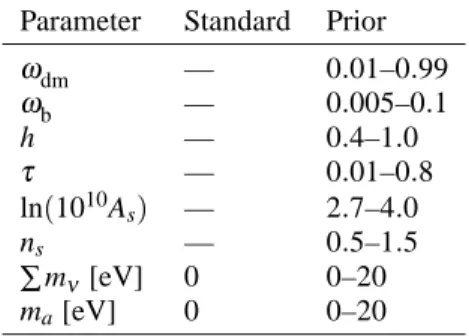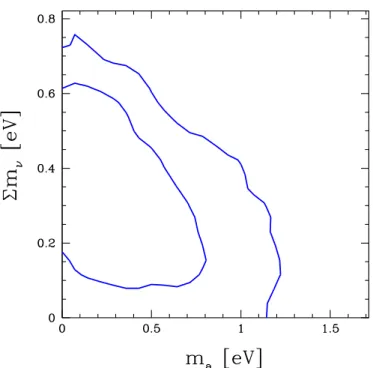MPP-2008-114
Cosmological limits on axions
Y. Y. Y. Wong, S. Hannestad†, A. Mirizzi and G. Raffelt
Max-Planck-Institut für Physik, Föhringer Ring 6, D-80805 München, Germany
†Department of Physics and Astronomy, University of Aarhus, DK-8000 Aarhus C, Denmark
Abstract. We derive cosmological limits on two-component hot dark matter consisting of neutrinos and axions. We restrict the large-scale structure data to the safely linear regime, excluding the Lyman-α forest. We derive Bayesian credible regions in the two-parameter space consisting of maand∑mν. Marginalising over∑mνprovides ma<1:02 eV (95% C.L.). In the absence of axions the same data and methods give∑mν<0:63 eV (95% C.L.).
Keywords: Axions, Cosmology, Dark matter PACS: 14.80.Mz, 98.80.-k, 95.35.+d
INTRODUCTION
The masses of the lightest particles are best constrained by the largest cosmic structures.
The well-established method of using cosmological precision data to constrain the cosmic hot dark matter fraction [1, 2] has been extended to hypothetical low-mass particles, notably to axions, in several papers [3, 4, 5, 6, 7]. If axions thermalise after the QCD phase transition, their number density is comparable to that of one neutrino family.
Neutrino mass limits are in the sub-eV range so that axion mass limits will be similar and therefore of interest to experiments like CAST [8] or the Tokyo axion helioscope [9]
that search for axions in the mass range around 1 eV. We summarise here our detailed limits on axions that were derived from the latest sets of cosmological data, including WMAP (5 years). Numerically our latest limit on ma[7] is almost identical to one that some of us have derived several years ago [4]. The main difference is that in the older paper the Lyman-α data were used that we now consider “too dangerous” in that they are prone to systematic errors. So, the latest data, that are safely in the linear regime, now do as well as the older data where Lyman-α was included.
AXIONS
The Peccei–Quinn solution of the CP problem of strong interactions predicts the ex- istence of axions, low-mass pseudoscalars that are very similar to neutral pions, except that their mass and interaction strengths are suppressed by a factor of order fπ=fa, where fπ 93 MeV is the pion decay constant, and fa the axion decay constant or Peccei–
Quinn scale [10]. In more detail, the axion mass is ma= z1=2
1+z fπmπ
fa =
6:0 eV
fa=106GeV; (1)
FIGURE 1. Axion relic density.
where z=mu=md is the mass ratio of up and down quarks. A value z=0:56 was often assumed, but it could vary in the range 0.3–0.6 [11]. A large range of fa values is excluded by experiments and by astrophysical and cosmological arguments [12]. Axions with a mass of order 10 µeV could well be the cold dark matter of the universe [13]
and if so will be found eventually by the ongoing ADMX experiment, provided that 1µeV<ma<100µeV [14].
In addition, a hot axion population is produced by thermal processes [15, 16]. Ax- ions attain thermal equilibrium at the QCD phase transition or later if fa <108 GeV, erasing the cold axion population produced earlier and providing a hot dark matter com- ponent instead. If axions do not couple to charged leptons (“hadronic axions”) the main thermalisation process in the post-QCD epoch is [15]
a+π$π+π: (2)
The axion–pion interaction is given by a Lagrangian of the form [15]
Laπ = Caπ
fπfa(π0π+∂µπ +π0π ∂µπ+ 2π+π ∂µπ0)∂µa: (3) In hadronic axion models, the coupling constant is [15]
Caπ = 1 z
3(1+z): (4)
Based on this interaction, the axion decoupling temperature in the early universe was calculated in Ref. [4], where all relevant details are reported. In Fig. 1 we show the relic axion density as a function of fa.
TABLE 1. Priors and standard val- ues for the cosmological fit parameters considered in this work. All priors are uniform in the given intervals (i.e., top hat).
Parameter Standard Prior ωdm — 0:01–0:99
ωb — 0:005–0:1
h — 0:4–1:0
τ — 0:01–0:8 ln(1010As) — 2:7–4:0
ns — 0:5–1:5
∑mν[eV] 0 0–20
ma[eV] 0 0–20
COSMOLOGICAL MODEL AND DATA
We consider a cosmological model with vanishing spatial curvature and adiabatic initial conditions, described by six free parameters, the dark matter density ωdm =Ωdmh2, the baryon densityωb=Ωbh2, the Hubble parameter H0 =h 100 km s 1Mpc 1, the optical depth to reionisationτ, the amplitude of the primordial scalar power spectrum ln(1010As), and its spectral index ns. In addition we allow for a nonzero sum of neutrino masses∑mν and a nonvanishing axion mass mawhich also determines the relic density shown in Fig. 1 by the standard relation between ma and fa. We show the priors on our parameters in Table 1.
We use the 5-year release of the WMAP cosmic microwave data [17, 18] that we analyse using version 3 of the likelihood calculation package provided by the WMAP team on the LAMBDA homepage [19], following closely the analyses of Refs. [20, 21].
For the large-scale galaxy power spectra we use Pg(k) inferred from the luminous red galaxy (LRG) sample of the Sloan Digital Sky Survey (SDSS) [22, 23] and from the Two-degree Field Galaxy Redshift Survey (2dF) [24]. We only use data safely in the linear regime where a scale-independent bias is likely to hold true. For 2dF this is kmax 0:09 h Mpc 1 (17 bands) and for SDSS-LRG kmax 0:07 h Mpc 1 (11 bands). Using data beyond kmax is in principle not forbidden, but would require some additional nonlinear modelling to describe the scale-dependent biasing. For cosmologies containing hot dark matter axions, care must be exercised when choosing the correct nonlinear model because of possible parameter degeneracies between the axion mass maand the nonlinear model parameters. See Ref. [25] for details.
We do not use Lyman-α data at all. The baryon acoustic oscillation peak was mea- sured in the SDSS luminous red galaxy sample [26]. We use all 20 points in the two- point correlation data and the corresponding analysis procedure [26]. We use the SN Ia luminosity distance measurements provided by Davis et al. [27].
FIGURE 2. 2D marginal 68% and 95% contours in the∑mν–maplane.
RESULTS
We use standard Bayesian inference techniques and explore the model parameter space with Monte Carlo Markov Chains (MCMC) generated using the publicly available COSMOMC package [28, 29]. We find the 68% and 95% 2D marginal contours shown in Fig. 2 in the parameter plane of∑mν and ma. Marginalising over∑mν provides
ma<1:02 eV(95% C:L:): (5) In the absence of axions the same data and methods give
∑mν <0:63 eV(95% C:L:): (6)
These axion mass limits are nicely complementary to the search range of the CAST experiment [8] and the Tokyo helioscope [9] that can reach to 1 eV or somewhat above.
While the hot dark matter limits are not competitive with the SN 1987A limits, it is intriguing that cosmology alone now provides both an upper and a lower limit for the allowed range of axion parameters.
ACKNOWLEDGMENTS
We acknowledge use of computing resources from the Danish Center for Scientific Com- puting (DCSC) and partial support by the European Union under the ILIAS project (contract No. RII3-CT-2004-506222), by the Deutsche Forschungsgemeinschaft under
the grant TR-27 “Neutrinos and Beyond” and by The Cluster of Excellence for Funda- mental Physics “Origin and Structure of the Universe” (Garching and Munich).
REFERENCES
1. J. Lesgourgues and S. Pastor, Phys. Rept. 429 (2006) 307 [arXiv:astro-ph/0603494].
2. S. Hannestad, Ann. Rev. Nucl. Part. Sci. 56 (2006) 137 [arXiv:hep-ph/0602058].
3. S. Hannestad and G. Raffelt, JCAP 0404 (2004) 008 [arXiv:hep-ph/0312154].
4. S. Hannestad, A. Mirizzi and G. Raffelt, JCAP 0507 (2005) 002 [arXiv:hep-ph/0504059].
5. A. Melchiorri, O. Mena and A. Slosar, Phys. Rev. D 76, 041303 (2007) [arXiv:0705.2695].
6. S. Hannestad, A. Mirizzi, G. G. Raffelt and Y. Y. Y. Wong, JCAP 0708, 015 (2007) [arXiv:0706.4198].
7. S. Hannestad, A. Mirizzi, G. G. Raffelt and Y. Y. Y. Wong, JCAP 0804, 019 (2008) [arXiv:0803.1585].
8. S. Andriamonje et al. [CAST Collaboration], JCAP 0704, 010 (2007) [arXiv:hep-ex/0702006].
9. Y. Inoue et al., arXiv:0806.2230 [astro-ph].
10. R. D. Peccei, Lect. Notes Phys. 741 (2008) 3 [arXiv:hep-ph/0607268].
11. W. M. Yao et al. [Particle Data Group], J. Phys. G 33 (2006) 1.
12. G. G. Raffelt, Lect. Notes Phys. 741 (2008) 51 [arXiv:hep-ph/0611350].
13. P. Sikivie, Lect. Notes Phys. 741 (2008) 19 [arXiv:astro-ph/0610440].
14. S. J. Asztalos, et al., Ann. Rev. Nucl. Part. Sci. 56 (2006) 293.
15. S. Chang and K. Choi, Phys. Lett. B 316 (1993) 51 [arXiv:hep-ph/9306216].
16. E. Massó, F. Rota and G. Zsembinszki, Phys. Rev. D 66 (2002) 023004 [arXiv:hep-ph/0203221].
17. G. Hinshaw et al., arXiv:0803.0732 [astro-ph].
18. M. R. Nolta et al., arXiv:0803.0593 [astro-ph].
19. Legacy Archive for CMB Data Analysis (LAMBDA), http://lambda.gsfc.nasa.gov 20. J. Dunkley et al. [WMAP Collaboration], arXiv:0803.0586 [astro-ph].
21. E. Komatsu et al., arXiv:0803.0547 [astro-ph].
22. W. J. Percival et al., Astrophys. J. 657 (2007) 645 [arXiv:astro-ph/0608636].
23. M. Tegmark et al., Phys. Rev. D 74 (2006) 123507 [arXiv:astro-ph/0608632].
24. S. Cole et al. [2dFGRS Coll.], Mon. Not. Roy. Astron. Soc. 362 (2005) 505 [arXiv:astro-ph/0501174].
25. J. Hamann, S. Hannestad, A. Melchiorri and Y. Y. Y. Wong, JCAP 0807 (2008) 017 [arXiv:0804.1789 [astro-ph]].
26. D. J. Eisenstein et al. [SDSS Collaboration], Astrophys. J. 633 (2005) 560 [arXiv:astro-ph/0501171].
27. T. M. Davis et al., Astrophys. J. 666 (2007) 716 [arXiv:astro-ph/0701510].
28. A. Lewis and S. Bridle, Phys. Rev. D 66 (2002) 103511 [arXiv:astro-ph/0205436].
29. A. Lewis, Homepage,http://cosmologist.info


